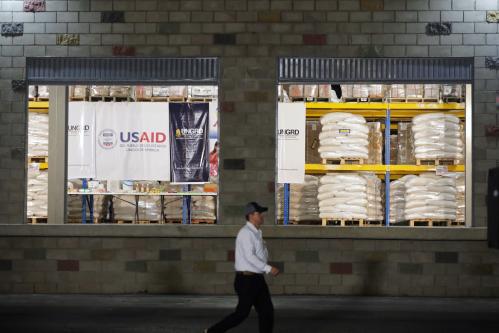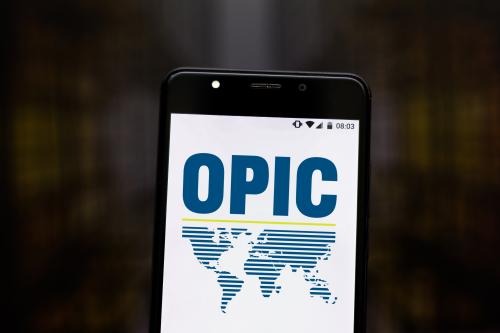In early November, the U.S. International Development Finance Corporation (DFC) invited public comments on the draft transparency policy and draft policy on public engagement by the DFC Board of Directors. The draft policies are a step in the right direction, but additional actions can be taken to improve the transparency and accessibility of the DFC’s data.
Friends of Publish What You Fund, a U.S.-based nonprofit that promotes greater transparency in U.S. aid and development flows, submitted comments in response to the request. A full copy of the comments is available, and here we highlight steps that could help the DFC reach its commitment to be the gold standard for transparency among development finance institutions (DFIs).
One of the drivers behind the creation of the DFC was to put development at the heart of its work. There are lots of factors at play in order to make the DFC’s development activities reach their potential. One of the critical foundations is transparency—around decisionmaking, impact, and results. Transparency can provide for better accountability, more shared learnings, better allocation of resources, and better development outcomes, particularly among those most in need of the benefits and most at risk to be harmed. Congress specifically called for more transparency in creating the DFC. Meeting this expectation will help earn the trust of both stakeholders and Congress.
The DFC has a mandate to contribute to better development outcomes, especially in the lower income countries, and improvements in its transparency can help the DFC fulfill that mandate.
The draft transparency policy moves in the right direction, but there is more the DFC should do to ensure that its information is transparent, accessible to the range of stakeholders, including beneficiaries, and used for decisionmaking. The full comments provide a number of specific recommendations; here are the highlights.
- There should be a presumption of disclosure for all information, with exceptions clearly defined and explained. Additionally, as is done at other DFIs that have right to disclosure policies, implementation guidelines to staff should be issued, so that the policy and procedures are consistently followed.
- Project level data needs to be more robust. There are four main areas where improvements can be made.
-
- Development impact. There is already a solid tool developed by the DFC—the Impact Quotient (IQ)—that both measures predicted impact and is used as a monitoring tool throughout the life of the project. The draft policy proposes to publish certain project level IQ information, which we support. We think there is additional information that is also important, such as monitoring reports and evaluations, ex post information on actual impact, including attribution of the DFC investment, and more detail about the investments and more qualitative information about why the investment of public money is needed. These recommendations are also in line with the recommendation of the Modernizing Foreign Assistance Network’s recommendations for the next administration.
- FATAA requires project level data. Under the BUILD Act, which authorized the DFC, project information is to be published quarterly. The Foreign Aid Accountability and Transparency Act of 2016 (FATAA), to which the DFC is subject—but not mentioned in the draft policy—sets out the “detailed” requirements for publication. As of yet, no publication has been made by the DFC to ForeignAssistance.gov. Publication to ForeignAssistance.gov will also result in publication of International Aid Transparency Initiative (IATI) data, which is a voluntary standard for reporting to a centralized registry that the United States agreed to join in December of 2011.
- Active Projects database. There is useful information about each project in this database, but much of the detail is in PDF files, making it less accessible and difficult to search. Consistent with U.S. policy, to the extent possible, the data should be open and machine-readable. It should also include the project pipeline, as other leading DFIs do. Finally, it would be helpful if the environmental and social information could be migrated to and made coherent with this database.
- OECD DAC data should be project level. Given the FATAA requirements to publish project level data on a quarterly basis, it would be helpful if the data the DFC provides to the OECD DAC (which currently includes only OPIC data) could be at the project, rather than at the aggregate level. A number of DFIs are already doing this.
- Stakeholder consultation. Expanding this note to the second draft policy covering public engagement with the DFC Board, the stakeholder outreach included in both policies is a welcome step, but the addition of providing adequate notice to all stakeholders and sufficient time to provide meaningful comments would help ensure that all interested parties have the opportunity to comment.
Publish What You Fund, the global campaign for aid and development transparency, is currently running a multistakeholder, collaborative research and advocacy project on improving the transparency of DFIs. The project’s goal is to create greater transparency using in-depth research into five main issues: basic project information; development impact; environmental and social safeguards and community accountability; the value of the investment (mobilization and structure of the deal); and financial intermediaries, offshore financial centers, and beneficial ownership. Each of these workstreams will involve granular research and findings into the policies and practices of twenty DFIs, followed by the publication of ambitious but actionable recommendations that will be used to advocate for greater transparency to drive better results and learnings. Many of our recommendations have been informed by the current work of this project.
The DFC has a mandate to contribute to better development outcomes, especially in the lower income countries, and improvements in its transparency can help the DFC fulfill that mandate.






Commentary
Movement on transparency at the Development Finance Corporation
December 2, 2020